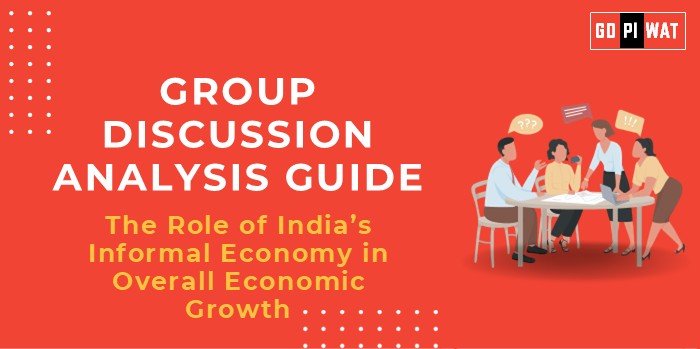📋 Group Discussion (GD) Analysis Guide: The Role of India’s Informal Economy in Overall Economic Growth
🌐 Introduction to the Topic
- 📌 Opening Context: “India’s informal economy, encompassing a vast array of unregistered and unregulated enterprises, constitutes a significant portion of the nation’s economic framework. Its pervasive presence and substantial contribution to employment make it a critical area of discussion for B-school aspirants.”
- 📌 Background: The informal sector in India includes activities not covered by formal arrangements, often lacking legal recognition and social protection. This sector has been instrumental in providing livelihoods, especially in rural and semi-urban areas, but faces challenges such as limited access to credit and vulnerability to economic shocks.
📊 Quick Facts and Key Statistics
- 👥 Employment Share: Approximately 80% of India’s workforce is engaged in the informal sector, highlighting its dominance in employment generation.
- 📈 GDP Contribution: The informal economy contributes about 50% to India’s Gross Domestic Product (GDP), underscoring its economic significance.
- 🌾 Sectoral Distribution: Agriculture remains a major component, with a significant portion of informal employment, followed by construction and small-scale manufacturing.
- 👩💼 Gender Participation: Women constitute a substantial part of the informal workforce, often in roles such as domestic help and small-scale retail, reflecting both opportunities and gender-specific challenges.
- 💳 Digital Integration: Post-demonetization and the introduction of the Goods and Services Tax (GST), there has been a notable increase in digital transactions within the informal sector, indicating a gradual shift towards formalization.
🤝 Stakeholders and Their Roles
- 🏛️ Government: Formulates policies aimed at formalizing the informal sector, providing social security, and enhancing access to credit. Initiatives like the Pradhan Mantri Mudra Yojana (PMMY) offer financial support to micro-enterprises.
- 🏦 Financial Institutions: Banks and microfinance institutions play a crucial role in extending credit facilities to informal enterprises, facilitating their growth and potential formalization.
- 🌍 Non-Governmental Organizations (NGOs): Work towards capacity building, skill development, and advocacy for the rights of informal workers, aiming to improve their socio-economic conditions.
- 💼 Private Sector: Engages with informal enterprises through supply chains and corporate social responsibility (CSR) initiatives, promoting inclusive growth.
- 🌐 International Organizations: Entities like the International Labour Organization (ILO) provide frameworks and support for improving labor standards and formalization processes in the informal economy.
🏆 Achievements and ⚠️ Challenges
Achievements
- 💼 Employment Generation: The informal sector serves as a vital source of employment, especially for unskilled and semi-skilled workers, thereby reducing unemployment rates.
- 🚀 Entrepreneurial Development: Facilitates the growth of micro and small enterprises, fostering entrepreneurship and innovation at the grassroots level.
- 💪 Economic Resilience: Demonstrates adaptability and resilience during economic downturns, maintaining economic activities and livelihoods.
Challenges
- ⚖️ Lack of Social Security: Informal workers often lack access to health insurance, pensions, and other social security benefits, leading to economic vulnerability.
- 💵 Limited Access to Formal Credit: Many informal enterprises rely on informal lending sources with high-interest rates due to the lack of collateral and formal credit history.
- 📜 Regulatory Hurdles: The process of formalization is often hindered by complex regulatory frameworks and bureaucratic challenges.
🌍 Global Comparisons
- 🇧🇷 Brazil: Implemented successful formalization policies through simplified tax regimes and social security benefits for informal workers, leading to a reduction in informality.
- 🇿🇦 South Africa: Faces challenges similar to India, with a large informal sector and ongoing efforts to integrate informal enterprises into the formal economy.
📖 Case Studies
- 🌱 Kerala’s Kudumbashree Mission: An example of integrating informal women workers into local governance and economic activities, enhancing their socio-economic status.
💡 Structured Arguments for Discussion
- Supporting Stance: “The informal economy is indispensable for India’s employment landscape, providing livelihoods to millions and sustaining economic activities across various sectors.”
- Opposing Stance: “The predominance of the informal sector poses challenges to economic development, including reduced tax revenues and lack of worker protections.”
- Balanced Perspective: “While the informal economy is crucial for employment and entrepreneurship, addressing its inherent challenges through targeted policies can enhance its contribution to sustainable economic growth.”
🗣️ Effective Discussion Approaches
- 📊 Opening Techniques:
- “With 80% of India’s workforce engaged in the informal sector, its role in the economy is both significant and complex.”
- “Despite contributing 50% to GDP, the informal sector’s lack of formal recognition presents challenges in policy implementation.”
- “The success of Kerala’s Kudumbashree Mission illustrates the potential of integrating informal workers into formal economic frameworks.”
- 📌 Counter-Argument Handling:
- Acknowledge the issue of lack of social security and formal credit access.
- Present solutions like PMMY and digital integration for financial support and market access.
- Support with data showcasing the resilience and contributions of the informal economy to GDP and employment.
📈 Strategic Analysis (SWOT)
- Strengths: Employment generation, flexibility and adaptability, and fostering entrepreneurial spirit.
- Weaknesses: Lack of social security, limited access to formal credit, and complex regulatory challenges.
- Opportunities: Digital integration, policy support for formalization, and global market linkages for sectors like handicrafts and textiles.
- Threats: Automation and technology, economic shocks, and rising inequality.
🎓 Connecting with B-School Applications
- 🌍 Real-World Applications: Insights from this topic can be applied to projects focusing on rural development, financial inclusion, and supply chain management in B-schools.
- 📚 Sample Questions:
- “How can digitization transform the informal sector in India?”
- “Discuss the challenges of formalizing India’s informal economy and suggest solutions.”
- 💡 Insights for Students:
- Focus on grassroots-level innovation and its scalability.
- Study case examples of successful informal sector integration into formal systems, like Kerala’s Kudumbashree.
- Explore microfinance as a bridge to formal economic participation.


